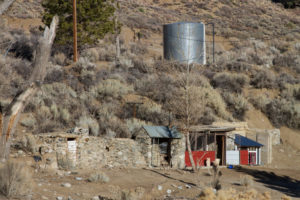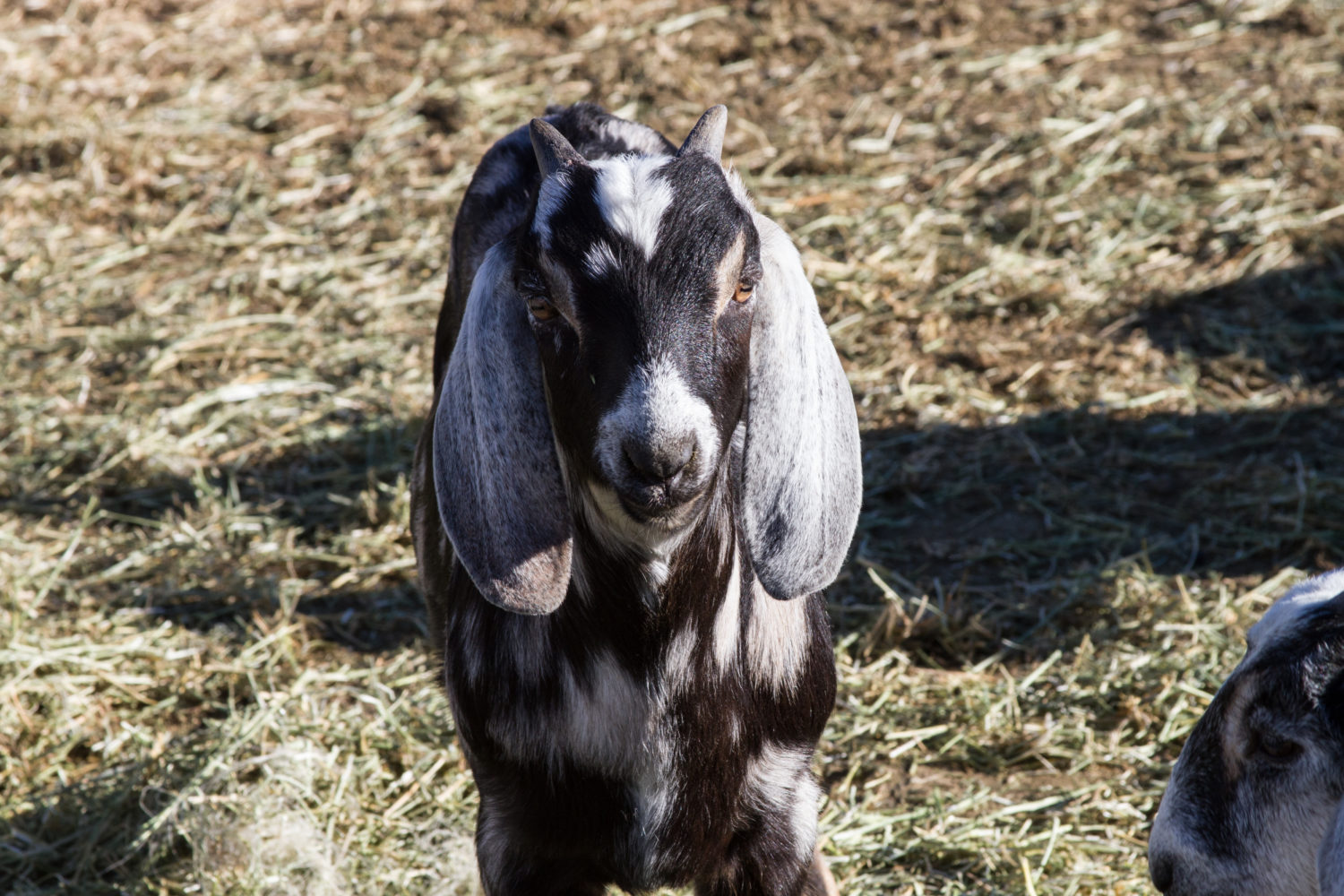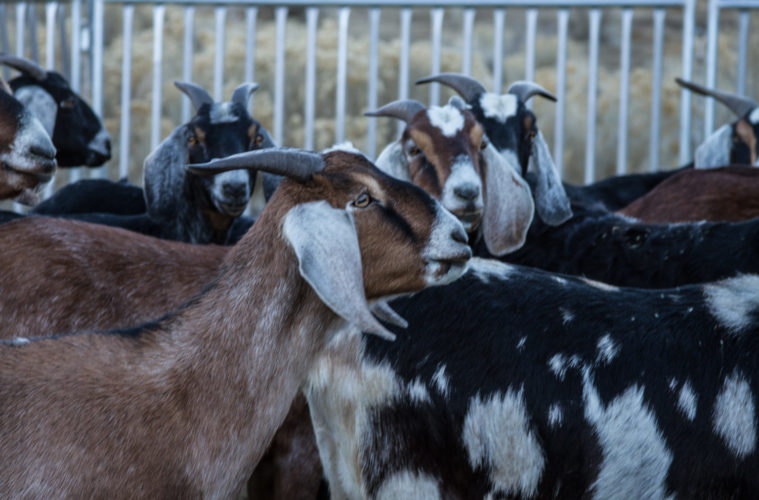VALYERMO, Calif. —Phones in San Bernardino buzz with an alert, a wildfire is burning near Big Pines Highway, and Highway 2, EVACUATION ORDER, LEAVE NOW. What to grab? If you’re Gloria Putnam the answer is some 60 goats, four great Pyrenees, 2 pigs, chickens, and a horse.
Her camera scans the ranch—a barn, two classic airstreams. In the distance, you can make out a tiny yellow homesteading cabin complete with porch and outdoor clawfoot tub. This is Angeles Crest Creamery, where Putnam hosts guests, interested in agri-tourism. Folks can stay here and learn to milk goats or hike with the goats as they forage on the ranch, and enjoy healthy and delicious food. It’s go-time, and even though she’s holding it together, you can hear her voice crack as her phone scans the ranch “Alright, these are the last goats remaining. I’m about to leave in this thing.” Putnam pans over to an evergreen bobcat. “I’m not coming back and—this might be the last time we see the ranch like this.”
About a decade ago, Putnam, a physicist, was living in Altadena and hosting an underground farmer’s market. She began with two goats which soon became twenty. She was interested in making cheese. She hosted “farm-to-table” dinners and cheese making classes. Her guests would comment, “Wow this is so sustainable.,” yet tugging at her was the unfinished truth, the feed, a grain she had sent in from somewhere else… a menace on her conscience. So she started thinking about it as an agricultural project. And then she looked for land.

Angeles Crest Creamery (Melissa Chadburn)
In 2012, Putnam bought a 70-acre ranch in the San Gabriels. It was just her, 20 goats, and one wheel of 2-year-old aged gouda. To stay here with the goats and eat the delicious cheese she made was not only satisfying—it was sustainable. That’s when she posed the larger question—, “Is it scalable?” The true dream—as she stated in an earlier interview in the L.A. Times, “If there were enough people who wanted to do this, if you filled these mountains with goats and shepherds, could this be a foodshed for Los Angeles? I don’t even know how to figure that out, but it’s kind of an interesting question.”
A question that inspired me to finally care about and better understand agriculture. Two years ago my partner and I moved out to the San Bernardino mountains. At the time I could not concern myself with the environment. I felt I was too damn busy worrying myself about the fact that my people have no money. By my people I mean workers, people who struggle. That could mean people whispering hail Mary’s for another stimulus check, or people who are scrambling to apply for unemployment, people who took three buses to get to work. That could mean people who spend their days wiping butts of people you love, or people you don’t know who try to get you to stay longer than you’re contracted for by talking to you about their relatives who never come to visit, could mean people who drive folks around and make sure they have cool snacks in the car, and suspending anything about themselves for a period of time — their family, their children at home in need of their company, that bedtime story they aren’t reading, those first steps they’re missing. Today that likely means when your Beloved is left to go through the same rituals over and over again that seem tedious but in the end make up a life, while you are splitting your time and attention between the people you love and being a worker. These people are the people I claim as my people.
Then Putnam set me straight, I’d come to visit her on assignment in December of 2018 and almost immediately she informed me, “The earth has 50 more harvests.” I dug into this number a bit more and it turns out—that’s an average. Still, the number of harvests we have left, whether it’s sixty or ninety or thirty, isn’t the point. The point is that if we do not change the way we farm and build—we will run out of soil. I went to the Angeles Crest Creamery to learn about goats but wound up learning about soil and that is exactly as Putnam would like it.

Angeles Crest Creamery (Melissa Chadburn)
Most of our farms in California, are in the fat central part, a place without water, where the only thing that thrives are large corporate-owned farms. Each of our farms, those owned and run by our people, went away. One by one, we went away. It’s the story of American farms and every small town since the latter half of the 20th century: we went away. Large landowners and financial interests undermining and gobbling up their smaller neighbors is a huge part of American farming lore. Because it happens. A lot. The big hustle in agriculture isn’t the food. It’s the real estate. Most rural counties are run by 2-3 families that quietly own a huge slice of the land. The landlords. They are the worst kind of beast. They are invisible, distant, and quiet, and none of us are bothering to understand the way it works. Put more succinctly, without farms, there’s no food. As I write this 34.5 percent of households with a child 18 and under have become food insecure as of late April 2020. Yet the federal food stamp program is facing budget cuts of almost thirty percent.
If this ranch burns down, we’re losing more than an airbnb or even a place to watch adorable baby goats vault and leap their tiny furry bodies off hay, we are losing prospective regenerative farming solutions—and a space to give rise to intellectual curiosity—the kind that saves lives.
Monday, September 20th, Putnam posts another video, she’s talking to Apple, the Queen B Doe of the herd she says, “So Apple listen, I know you’ve been pretty worried about what’s going on, but this morning Jim drove up there and he was able to get a look at the ranch and he said as far as he could tell, nothing had burned really, even most of the forage land was saved.” Here we can hear her exhale then her voice cracks again, you can tell she’s crying, “That’s right, you’re gonna get to go home. You’re gonna get to go home and finish the food.”
For further updates on Angeles Crest Creamery you can follow them on instagram, and please consider donating to their bobcat fire hay fund. It costs Putnam about $180/day to feed the goats during the evacuation it costs Putnam about $180/day. If you’d like to help the ranch during this time, you can “purchase” feed donations in $20 increments here.
Advertising disclosure: We may receive compensation for some of the links in our stories. Thank you for supporting LA Weekly and our advertisers.

